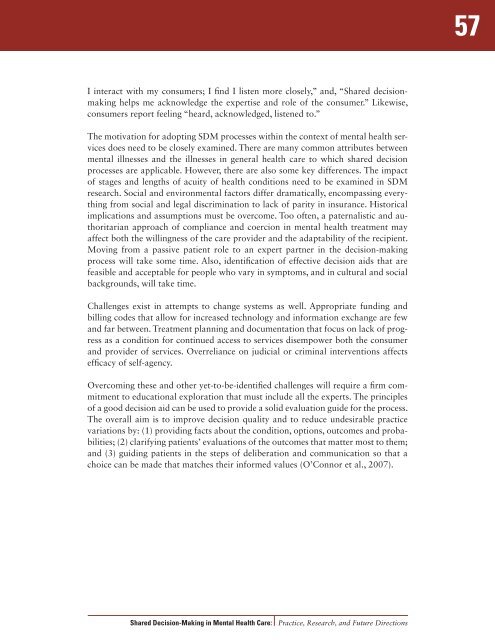Shared Decision-Making in Mental Health Care - SAMHSA Store ...
Shared Decision-Making in Mental Health Care - SAMHSA Store ...
Shared Decision-Making in Mental Health Care - SAMHSA Store ...
Create successful ePaper yourself
Turn your PDF publications into a flip-book with our unique Google optimized e-Paper software.
57I <strong>in</strong>teract with my consumers; I f<strong>in</strong>d I listen more closely,” and, “<strong>Shared</strong> decisionmak<strong>in</strong>ghelps me acknowledge the expertise and role of the consumer.” Likewise,consumers report feel<strong>in</strong>g “heard, acknowledged, listened to.”The motivation for adopt<strong>in</strong>g SDM processes with<strong>in</strong> the context of mental health servicesdoes need to be closely exam<strong>in</strong>ed. There are many common attributes betweenmental illnesses and the illnesses <strong>in</strong> general health care to which shared decisionprocesses are applicable. However, there are also some key differences. The impactof stages and lengths of acuity of health conditions need to be exam<strong>in</strong>ed <strong>in</strong> SDMresearch. Social and environmental factors differ dramatically, encompass<strong>in</strong>g everyth<strong>in</strong>gfrom social and legal discrim<strong>in</strong>ation to lack of parity <strong>in</strong> <strong>in</strong>surance. Historicalimplications and assumptions must be overcome. Too often, a paternalistic and authoritarianapproach of compliance and coercion <strong>in</strong> mental health treatment mayaffect both the will<strong>in</strong>gness of the care provider and the adaptability of the recipient.Mov<strong>in</strong>g from a passive patient role to an expert partner <strong>in</strong> the decision-mak<strong>in</strong>gprocess will take some time. Also, identification of effective decision aids that arefeasible and acceptable for people who vary <strong>in</strong> symptoms, and <strong>in</strong> cultural and socialbackgrounds, will take time.Challenges exist <strong>in</strong> attempts to change systems as well. Appropriate fund<strong>in</strong>g andbill<strong>in</strong>g codes that allow for <strong>in</strong>creased technology and <strong>in</strong>formation exchange are fewand far between. Treatment plann<strong>in</strong>g and documentation that focus on lack of progressas a condition for cont<strong>in</strong>ued access to services disempower both the consumerand provider of services. Overreliance on judicial or crim<strong>in</strong>al <strong>in</strong>terventions affectsefficacy of self-agency.Overcom<strong>in</strong>g these and other yet-to-be-identified challenges will require a firm commitmentto educational exploration that must <strong>in</strong>clude all the experts. The pr<strong>in</strong>ciplesof a good decision aid can be used to provide a solid evaluation guide for the process.The overall aim is to improve decision quality and to reduce undesirable practicevariations by: (1) provid<strong>in</strong>g facts about the condition, options, outcomes and probabilities;(2) clarify<strong>in</strong>g patients’ evaluations of the outcomes that matter most to them;and (3) guid<strong>in</strong>g patients <strong>in</strong> the steps of deliberation and communication so that achoice can be made that matches their <strong>in</strong>formed values (O’Connor et al., 2007).<strong>Shared</strong> <strong>Decision</strong>-<strong>Mak<strong>in</strong>g</strong> <strong>in</strong> <strong>Mental</strong> <strong>Health</strong> <strong>Care</strong>: Practice, Research, and Future Directions
















